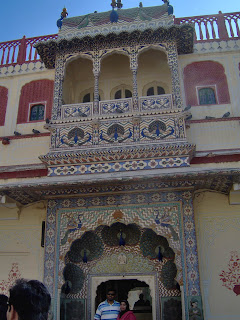This is one of the most amazing architectural rabbit holes I've ever been down. No amount of photographs can do justice to it; there are unlimited perspectives and flourishes to shoot from and enjoy.
More than just a wellspring of photographic inspiration, the
City Palace is a meeting place for the
royal families' public and private lives and the concerns of the public that
supported (and continues to support) them. Since independence, I get the
impression that the royal family tends to be regarded more symbolically, and
it's telling that the admission fee for the City Palace and its museum and
other areas go to the family. I don't know what their interests are, nor in
what stocks, companies, industries, they've invested. I have no idea what
they're like. But to the Rajasthanis, I don't think it matters.
This leads to pondering the nature of the evolution of the
country of India, overall. From pre-Moghul invasion up through the Raj and now
to independence as a sixty-four year old democracy, one wonders how the average
Rajasthani feels about the descendents of the great Rajas. Coming from a very
different historical background, it's hard for me to relate to or support a
monarchy or a colonialist mandate. But I suspect that deep in the heart of more
than just a few, there's a soft spot for what might be conceived of as golden
eras.
Sadly, I don't think I could support that, although I suspect
equally that the rose-coloured glasses through which the past is often
perceived isn't the exclusive province of those who support these lineages.
Basically, I rather feel that most of these rulers
(specifically, those under consideration here) were populists. Much of what I
glean of their stories is that they really wanted to do right by their people.
The downside, of course, to someone who does promote a democracy is that the
potential for abuse is still too great to assume that any ruler is an astute
and/or altruistic philosopher king. There's a reason the Divine Right of Kings
hasn't survived too well. That said, I respect what some of the Rajas and
Maharajas of Jaipur attempted to accomplish and that I can scarce begrudge them
the memorial to their line in the form of the City Palace.
 |
| The Mubarak Mahal, the "Auspicious Palace" or the Welcome Palace |
|
 |
| Ridhi Sidhi Pol, leads to the Pritam Niwas Chowk. |
 |
| The Green Gate to Pritam Chowk. Represents spring. |
 |
| The Peacock Gate, one of the entrances to the Chandra Mahal. Represents autumn. |
 |
| The Chandra Mahal. The Royal Residence, only the bottom floor is opened to the public. |
Details and Flourishes:
 |
| Top part of a mirror depicting Shakyamuni Buddha. |
 |
| More of the mirror. If memory serves, this is in the Diwan I Khas. |
 |
| One of the Gangajali, with a weight of 345 kg, height 5’3″, circumference of 14’10″ and a volume of 900 imperial gallons or 4091 liters. And it's all one single cast. There are two, both commissioned by Sawai Madho Singh II who was a devout Hindu and had them made to transport water from the Ganges River on his trip to England in 1901. These are found at the entrance to the Diwan-I-Khas |
More reference:
Do check out this blog (highly informative and great photos): http://karuneshjohri.com/travel/city-palace-jaipur/


















No comments:
Post a Comment